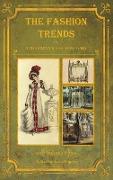- Start
- The Fashion Trends of Ackermann's Repository of Arts, Literature, Commerce, Etc.: With Additional Pictorial Reference to All Other Plates Issued 1819-
The Fashion Trends of Ackermann's Repository of Arts, Literature, Commerce, Etc.: With Additional Pictorial Reference to All Other Plates Issued 1819-
Angebote / Angebote:
So far we have followed Rudolph Ackermann's rich publishing career for 10 successful years. We saw him expand his popularity of a saddle maker and carriage builder into the print and book publication. His elegant shop was popular among artists and members of the upper London society. His early adoption of gas allowed the customers to appreciate the fine quality of his art prints in the well lit gallery. His reputation has grown to the extend that for one to be seen at the Ackermann's print shop was to be perceived as sophisticated and tasteful. His books and prints informed the clients about the latest designs in fashion, interiors, furniture and architecture among others. In 1822 Ackermann introduced his very successful annual Forget-me-not gift book. He developed close contacts with other countries and opened shops in Mexico and Guatemala, Colombia, Argentina and Peru. He published over 100 books in Spanish, and played important part in the education of the newly independent South American Republics. During the period of 1819-1823 the Repository of Arts also enjoyed continued prosperity. The monthly magazine was distributed internationally and kept coverage of wide variety of subjects on its pages. Although it still maintained its growing emphasis on lady's interests it still informed the subscribers on current political events and developments, and new technological inventions and advancements. Cutting edge fashion designs continue to be present as well as fashionable furniture, interiors. During this period a special place was given, in each issue, to fashionable country houses and estates. The readers enjoyed beautiful views of the parks and homes of distinguished members of the British society.After the death of King George the Third in 1820 we see the return of the mourning fashions on the pages of the Repository followed by increased interest in court, ball and evening styles after the coronation of King George IV in July 1821. By the end of 1823 despite Ackermann's deteriorating health, the rise of the Repository continues unaffected, and the quality of the plates published is still unsurpassed by his contemporaries. British society comes alive in vibrant detail to us despite the passage of time.
Folgt in ca. 15 Arbeitstagen
